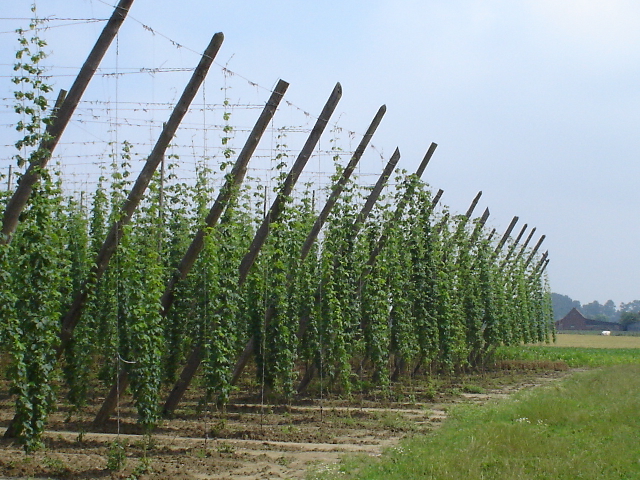|
|
The
Middle Ages were a difficult time for brewers. Grains had to be
dried over open fires and were often burned and girdled with
smoke. Brewing water was dirty and contaminated with
bacteria. Yeast had not been discovered, and beer fermentation
was often accomplished by the wild yeasts and bacteria in the air or on
the brewery’s old wooden stirring paddle. Worst of all, to
balance the sweet (or oftentimes sour) nature of beer, brewers would
add a staggering array of peculiar vegetables, spices, herbs and even
hay. Beer drinkers of the time never knew what they were going to
get.
About 400 years ago a huge leap in beer brewing occurred – some lucky,
desperate brewer decided to add hops to his boiling kettle. Hops
(scientifically known as Humulus
lupulus) are vines that grow wild all
across Europe and produce fragrant flower cones full of spicy, bitter,
sticky resins. When the cones are boiled in wort (unfermented
beer) for an hour or more, the resins produce a delightful bitterness
that is a perfect counterpoint to barley malt sweetness. If the
brewer tossed in hops a few minutes before the end of the boil, then an
agreeable, floral flavor and aroma emerged in the beer. Dried
hops added directly to the beer’s serving barrel (in a process known as
dry-hopping) adds an even greater depth of floral aromatics.
The blessed brewers then quickly noticed that hopped beers resisted
souring and stayed fresh for a much longer time. This is due to
the antibacterial and antioxidant qualities of the miraculous hop
resins. Despite all this, some old-school brewers of the time
denounced the hop as an invasive weed filled with vile toxins that
should never be added to the brew. But the multitudinous merits
of hops in beer soon won over the non-believers, and a new brewing
tradition was born. In 1516 Germany went so far as to enact
Europe’s first written law protecting consumers – the famous
Reinheitsgebot dictated that German beer should contain only three
ingredients – water, malt and hops (again, brewers were still in the
dark about yeast).
Hops grace almost every beer made today, and 98% of all hops are grown
in five countries – England, Belgium, Germany, Czech Republic and the
United States. These nations produce hops with characteristic
sets of notable flavors and aromas. Hops from the U.K. impart a
woody, tea-like note to English ales. Belgian, German and Czech
varieties bless their brews with delicate flavors and aromas of
flowers. Most American hops are raised in the states of Oregon
and Washington and confer distinctive overtones of pine and citrus to
American ales.
Hop varieties do have personalities – much like the various beer styles
that they accompany. Beers with light hop usage are often called
“malty,” as their main flavor profiles are produced by sugars in the
barley malt. In contrast, “hoppy” beers pack a big hop
bitterness, flavor and/or aroma that often dominate the malt
background. Hoppy beers are very much an acquired taste for most
new beer drinkers, and it often takes years of tasting to begin to
appreciate a fully hopped, bitter ale. Beer lovers who have been
smitten with hop love are called “hop heads,” but for those still in
hop appreciation training, here are a few beers to sample…
- Pilsner Urquell is the original Bohemian Pilsner from the
Czech town of Pilsen. Unlike American lagers that impersonate
true “pilsners,” Urquell explodes with elegant and flowery hop aroma,
flavor and bitterness to balance the golden malt. Unfortunately,
this beer is sold in green bottles that do a pitiful job of protecting
it from light, and light exposure can turn hop aroma into something
very reminiscent of a skunk. All beer in green and clear bottles
is sensitive to the light of day.
- Most English ales are balanced more toward malt than hops,
but American Pale Ales like Sierra Nevada are just the opposite.
Sierra Nevada invented the American Pale Ale back in the 1980s and was
the first brewery to use the now popular Cascade hop that has a
decidedly grapefruit-like note.
- Rogue Shakespeare Stout hails from Oregon and offers a
mouthful of dark, roasted malts (that are very espresso-like) backed up
by a powerful, citrusy hop bitterness. This is one of the world’s
richest and most flavorful stouts.
- India Pale Ales started in the 1800s as versions of English
Ales that were heavily hopped in order to stay fresh along the journey
to the British military in India. American craft brewers have
perfected the hop explosiveness of a stalwart IPA with intense examples
like Sweetwater IPA and Anchor Liberty Ale.
- For the brave of heart there are far-out ales with high
percentages of
alcohol to go along with their lavish use of hops. Imperial IPAs
have almost double the amount of malt, hops and alcohol as standard
examples, and Terrapin Rye Squared and Great Divide Hercules IPA are
two outstanding examples that will astound the taste buds.
|


